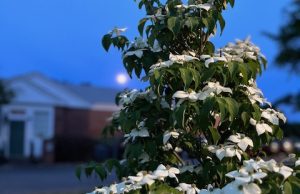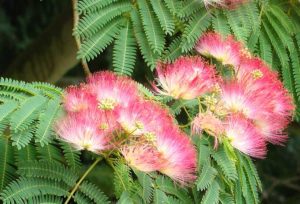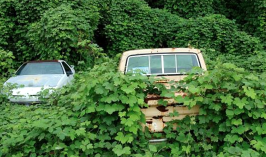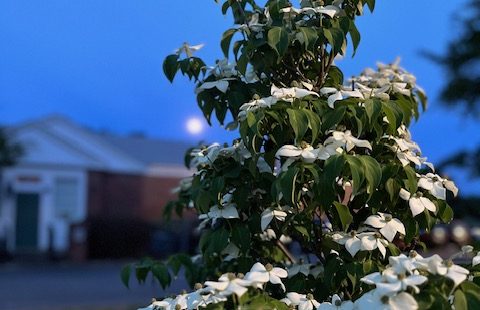By Jenna Jones, Trussville Tree Commission
A recent sister trip to South Carolina involved a bit of meandering (some call it lost) through the Appalachian foothills between North & South Carolina. It was early April and the native dogwoods were in their glory! I was delighted, as this visual is no longer as common in the southeastern landscape.

Beauty: Kousa dogwood in May moonlight. Planted by Girl Scout Troop 30679 in February as Trussville’s designated Arbor Week tree. They named her Treesa.
Unfortunately, our native dogwoods have become susceptible to a variety of cankers and fungal growths.
Fortunately, an Asian species – Kousa (which simply means dogwood) – was introduced years ago as an option in the southeastern landscape. The Kousa is a hardier and more disease resistant dogwood. A later spring bloomer than the native, its flowers are insignificant; but its bracts put on a snowy white show – a pleasant surprise in the landscape, when many spring trees have dropped their blooms! The Kousa has an attractive transition in the fall as well with scarlet/purple leaves and fruit that resembles raspberries. All this to say: all non-native trees are not to be mistaken as invasive species!
The import and export of botanicals between continents has been a trade for centuries. (Founding Gardeners and The Brother Gardeners by Andrea Wulf are good reads.) However, not all intentions of trade were good nor well thought out: enter the charming mimosa tree. It was introduced as an ornamental in the 1700’s. Unfortunately, it acclimated easily to the southern climate and became competitive with the native trees.
By mid-20th century, the tree had become common in the southern landscape. As a child growing up on Church Street, there was a large mimosa dead center in our front yard. Because it was an easy climber, the tree was a neighborhood kid magnet!

Beast: Mimosa – Beware the lure of her charm!
Frankly, I loved the pink powder puff blooms followed by seeds pods that looked like enormous English peas. However, our dad looked at the tree through a different lens: it was messy, the seeds could be toxic to animals, and it was invasive. Growing up near Bald Rock Mountain, he had a protective instinct for native landscapes – one mimosa meant thousands more in the native habitats. I sensed the tree’s days were numbered.
Finally (to our dad’s delight), the mimosa’s bark split, and every insect imaginable was invited to a sap feast! Our dad could now justify removing the neighborhood’s best entertainment. We cried but moved on with eyes focused on the neighborhood oaks, which looked like Mt. Everest to a child. As an adult, I now share that same protective spirit as my dad – no longer romanticizing this tree but witnessing the devastation it is causing in the native landscapes. Driving on I-59 in summer is painful.
The mimosa tree is just one example of many invasive botanicals (grasses, vines, trees, perennials) in Alabama’s landscape. Perhaps, kudzu is first to come to mind, but there are many more. The first defense is identity, then specialized control. Please become familiar with the extensive list at the Alabama Cooperative Extension System: Invasive Species
And in the meantime, be careful where you park!









